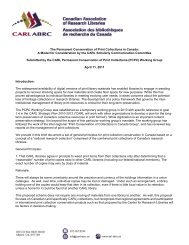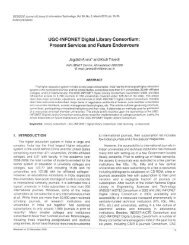PDF - CARL - ABRC
PDF - CARL - ABRC
PDF - CARL - ABRC
Create successful ePaper yourself
Turn your PDF publications into a flip-book with our unique Google optimized e-Paper software.
For journals in the social sciences and humanities (SSH), publishers are eligible for government<br />
grants from the federal government (e.g. SSHRC) as well as the Quebec government, although,<br />
these grants do not generally cover the full costs of publishing. The SSHRC subsidy program<br />
currently supports over 150 Canadian journals. A recent article describing the situation with<br />
Canadian SSH journals asserts, “Were subsidies not in place, few Canadian social science and<br />
humanities (SSH) journals would exist: the market is simply not big enough to support such<br />
publications. Without such journals, Canadian research would become far less visible.” 6<br />
Several university libraries in Canada 7 have recently launched open access funds that enable their<br />
authors to publish in fee-based open access journals. The funds divert subscription monies<br />
towards open access publications and pay for article processing fees or institutional memberships.<br />
The case studies detailed below demonstrate some of the new funding models being employed by<br />
open access journals/publishers in Canada.<br />
Case Study: Canadian Journal of Sociology/Cahiers canadiens de sociologie<br />
http://ejournals.library.ualberta.ca/index.php/CJS/index<br />
The Canadian Journal of Sociology is an open access journal that publishes rigorously peerreviewed<br />
research articles and innovative theoretical essays by social scientists from around the<br />
world, providing insight into the issues facing Canadian society as well as social and cultural<br />
systems in other countries.<br />
In 2007, the journal transitioned from subscription model to open access. The editor made the<br />
decision to adopt an open access model principally in order to broaden the journal’s readership in<br />
Canada and abroad, ultimately improving the impact of the journal. In addition, the editor<br />
believed that the move was necessary in order to attract a younger generation of readers and<br />
authors.<br />
As part of the transition, the journal left University of Toronto Press and moved to the University<br />
of Alberta site. The editor discontinued the print version of the journal and since 2008, they have<br />
published in electronic format only, using the OJS software. The costs of publishing declined<br />
significantly because most of their subscription revenues “went to cover the costs associated with<br />
producing a print volume, such as printing, subscription management and postage” 8 . The major<br />
costs for the journal are the salary of the editorial assistant and some funds to occasionally<br />
purchase new technology.<br />
6<br />
Lorimer et al. pg. 175<br />
7<br />
University of Calgary, University of Ottawa, and Simon Fraser University have all recently announced OA funds.<br />
8<br />
Haggerty, pg. 1<br />
7












